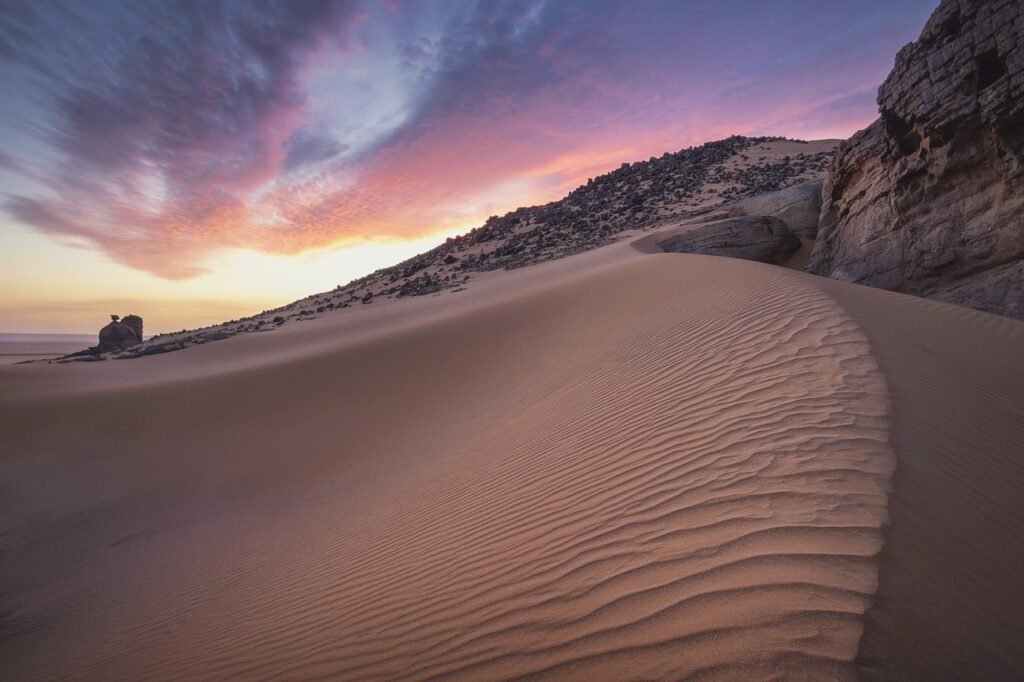The largest desert in the world is the Sahara Desert
The Sahara Desert: A Vast, Arid Landscape
The Sahara Desert, the largest desert on Earth, stretches across much of North Africa. Its vast expanse covers approximately 3.6 million square miles, making it roughly the size of the United States. Known for its extreme heat, arid conditions, and iconic sand dunes, the Sahara Desert is a harsh but fascinating environment.
Geographic Features:
Sand Dunes: The Sahara is home to some of the tallest sand dunes in the world, including the Erg Chebbi and Erg Chegaga. These dunes can reach heights of over 500 feet.
Plateaus: The desert is also characterized by vast plateaus, such as the Tibesti Plateau and the Aïr Massif, which are dotted with volcanic peaks and canyons.
Wadis: Wadis are dry riverbeds that only contain water after heavy rainfall. They are important sources of vegetation and wildlife in the desert.
Climate:
Extreme Temperatures: The Sahara Desert experiences some of the hottest temperatures on Earth. Daytime temperatures can reach well over 100°F (38°C), while nighttime temperatures can drop significantly, especially in the winter.
Low Precipitation: The Sahara Desert is extremely arid, with annual rainfall averaging less than 4 inches. This lack of moisture contributes to the desert’s harsh conditions.
Biodiversity:
Despite its harsh environment, the Sahara Desert is home to a variety of plant and animal species that have adapted to the extreme conditions. These include:
Plants: Desert plants, such as cacti, succulents, and acacia trees, have developed adaptations to conserve water, such as deep roots, waxy leaves, and the ability to store water in their tissues.
Animals: Desert animals, such as camels, scorpions, lizards, and snakes, have also evolved to survive in the harsh environment. These animals have adaptations to regulate their body temperature, conserve water, and avoid predators.
Human History:
The Sahara Desert has a rich history, with evidence of human occupation dating back thousands of years. Ancient civilizations, including the Egyptians and Romans, lived in and around the desert. Today, the Sahara is home to a small population of nomadic people who continue to live traditional lifestyles.
The Sahara Desert is a vast and awe-inspiring landscape that offers a glimpse into the harsh beauty of nature. Its extreme conditions have shaped the lives of countless people and animals over the centuries, and it continues to be a source of fascination and wonder.
======================================================================
The largest desert in the world :

======================================================================
The largest desert in the world is the Sahara Desert The largest desert in the world is the Sahara Desert The largest desert in the world is the Sahara Desert The largest desert in the world is the Sahara Desert The largest desert in the world is the Sahara Desert The largest desert in the world is the Sahara Desert The largest desert in the world is the Sahara Desert The largest desert in the world is the Sahara Desert The largest desert in the world is the Sahara Desert The largest desert in the world is the Sahara Desert The largest desert in the world is the Sahara Desert The largest desert in the world is the Sahara Desert
The largest desert in the world is the Sahara Desert The largest desert in the world is the Sahara Desert The largest desert in the world is the Sahara Desert The largest desert in the world is the Sahara Desert The largest desert in the world is the Sahara Desert The largest desert in the world is the Sahara Desert The largest desert in the world is the Sahara Desert The largest desert in the world is the Sahara Desert The largest desert in the world is the Sahara Desert The largest desert in the world is the Sahara Desert The largest desert in the world is the Sahara Desert The largest desert in the world is the Sahara Desert
The largest desert in the world is the Sahara Desert The largest desert in the world is the Sahara Desert The largest desert in the world is the Sahara Desert The largest desert in the world is the Sahara Desert The largest desert in the world is the Sahara Desert The largest desert in the world is the Sahara Desert The largest desert in the world is the Sahara Desert The largest desert in the world is the Sahara Desert The largest desert in the world is the Sahara Desert The largest desert in the world is the Sahara Desert The largest desert in the world is the Sahara Desert The largest desert in the world is the Sahara Desert



